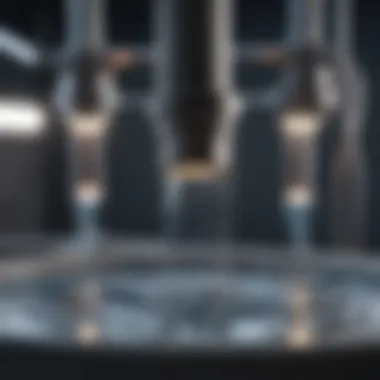Electrolyzed Water Systems: Mechanisms and Applications


Intro
Electrolyzed water systems have gained attention for their unique ability to purify and disinfect water through the electrolysis process. This technology has implications across various sectors such as healthcare, food safety, and environmental sustainability. Understanding the mechanisms and applications of these systems is essential for appreciating their potential impact on modern society.
The basic principle involves the use of an electrolyzer that applies electric current to water, resulting in the generation of two types of electrolyzed water: acidic and alkaline. These forms exhibit distinct properties and effectiveness in disinfection, cleaning, and sanitizing. As industries increasingly seek safer and more environmentally friendly solutions, electrolyzed water systems present a viable alternative to traditional chemical treatments.
In this article, we will explore the fundamental aspects of electrolyzed water systems, including the underlying chemistry, applications in various fields, and future advancements in technology. This comprehensive guide aims to provide researchers, educators, and enthusiasts with a thorough understanding of this innovative water treatment approach.
Prologue to Electrolyzed Water Systems
Electrolyzed water systems represent a significant advancement in water treatment technology. They offer diverse applications across various industries, primarily due to their unique capabilities in sanitation and disinfection. Understanding this technology is crucial for those in fields such as healthcare, food safety, and agriculture. The importance of this topic lies in its potential impact on public health and environmental sustainability.
Definition and Basic Principles
Electrolyzed water is produced through a process called electrolysis. This involves passing an electric current through water mixed with electrolytes, resulting in the separation of water into its fundamental components, hydrogen and oxygen. The process generates two types of water: anolyte, which is typically acidic and possesses strong antibacterial properties, and catholyte, which is alkaline and can be used for various applications. The effectiveness of electrolyzed water in disinfection comes from the oxidative properties of the anolyte. This water can inactivate pathogens, including bacteria and viruses, making it a valuable tool for maintaining hygiene.
Historical Context and Development
The concept of using electrolyzed water is not new. Its roots can be traced back to the early 20th century when scientists first explored the effects of electrolyzed solutions on microorganisms. Initially, these systems were primarily used in laboratory settings. Over decades, advancements in technology and a growing awareness of hygiene have led to broader applications. Today, electrolyzed water systems are employed in hospitals, food processing plants, and even household cleaning. The ongoing research continues to innovate this technology, revealing new methods and settings for its application, which contributes to its growing significance in modern sanitation solutions.
Chemical Foundations of Electrolysis
Understanding the chemical foundations of electrolysis is paramount to grasping how electrolyzed water systems function. The process of electrolysis involves the use of electricity to drive a chemical change, specifically the decomposition of compounds, such as water, into their constituent parts. This foundational knowledge is crucial as it underpins the mechanisms through which electrolyzed water achieves its intended actions, especially in sanitation and disinfection applications.
Electrolytic Cell Components
An electrolytic cell is the heart of any electrolysis process. It consists of several key components: the anode, the cathode, the electrolyte, and the energy source. The anode is where oxidation occurs, while the cathode is the site of reduction. The electrolyte, typically a salt solution or pure water, serves as the medium through which ions move, facilitating the conductance of electricity.
The efficacy of an electrolytic cell relies heavily on the materials used for the electrodes. Materials such as titanium or stainless steel are often chosen for their conductivity and resistance to corrosion. The energy source, which can vary from batteries to more robust solutions, must provide sufficient voltage to initiate and maintain the electrolysis process.
Chemical Reactions Involved
During electrolysis, specific reactions dictate the behavior and outcomes of the process. For the electrolysis of water, two primary reactions occur:
- At the Anode: Water molecules are oxidized, releasing oxygen gas and protons. This reaction can be summarized as:[ 2H_2O(l) \rightarrow O_2(g) + 4H^+(aq) + 4e^- ]
- At the Cathode: Protons are reduced to form hydrogen gas. The reaction can be expressed as:[ 4H^+(aq) + 4e^- \rightarrow 2H_2(g) ]
These reactions reflect the net result of electrolysis, emphasizing the production of both oxygen and hydrogen gases. The balance and effectiveness of these reactions are essential, as they directly relate to how energy-efficient the system is and how effectively the electrolyzed water can be utilized for its applications.
Role of Electrolytes
Electrolytes play a critical role in the electrolysis process. They are substances that dissociate into ions when dissolved in water, increasing its electrical conductivity. Common electrolytes used in electrolyzed water systems include sodium chloride and potassium sulfate.
The choice of electrolyte can significantly affect the performance of the electrolysis process. For instance, sodium chloride is commonly used in generating sodium hypochlorite solutions, which are effective disinfectants. However, the concentration of the electrolyte must be managed to optimize the reactions and minimize unwanted byproducts.
In summary, the chemical foundations of electrolysis encompass not just the basic reactions involved, but also the important design and material considerations of electrolytic cells and the pivotal role of electrolytes. Understanding these fundamentals is essential for applying electrolyzed water systems effectively across various industries.
Types of Electrolyzed Water
Understanding the types of electrolyzed water is crucial for comprehending their various applications and benefits. Each type exhibits distinct properties and mechanisms of action, making them suitable for different contexts. The main categories of electrolyzed water are anolyte, catholyte, sodium hypochlorite, and ozone-infused solutions. This section will explore these kinds in detail, highlighting their significance in applications such as sanitation, food safety, and health care, while also considering their unique characteristics and functional advantages.
Anolyte and Catholyte Water


Anolyte and catholyte water arise from the process of electrolysis, where water is split into positive and negative ions. Anolyte typically possesses strong oxidizing properties. It is effective against bacteria, viruses, and pathogens. This makes it valuable in sanitation practices. Often, anolyte is used in food processing environments to reduce microbial load on surfaces and equipment.
Catholyte, in contrast, tends to be alkaline and contains higher concentrations of hydroxyl ions. It has gentle properties, making it suitable for applications requiring minimal disruption. For instance, catholyte water can be used for cleaning sensitive items in medical settings without risking damage. Each type serves a vital purpose within its respective context, demonstrating the multifaceted nature of electrolyzed water systems.
Sodium Hypochlorite Solutions
Sodium hypochlorite solutions are one of the most widely used forms of electrolyzed water. Sodium hypochlorite is generated through the electrolysis of sodium chloride solution, resulting in a powerful disinfectant. This solution is commonly utilized in various sectors, including municipal water treatment, swimming pools, and as a surface sanitizer in food production.
The effectiveness of sodium hypochlorite lies in its ability to release chlorine upon contact with contaminants. This reaction results in the destruction of bacteria and eliminates many harmful microorganisms. One major advantage is that it can be used in a diluted form, making it both effective and economical.
However, there are important considerations to keep in mind. Sodium hypochlorite can produce potentially toxic byproducts when it interacts with organic matter; thus, its use must be managed properly to ensure safety.
Ozone-Infused Electrolyzed Water
Ozone-infused electrolyzed water is another advanced form of sanitation solution. Ozone (O3) is a powerful oxidizing agent. It is effective at disinfecting and purifying water without the addition of chemical residues. The infusion of ozone occurs through a process where ozone gas is dissolved into water, enhancing its antimicrobial properties.
This type of electrolyzed water can be used in various industries, including healthcare and food services. Its benefits include rapid disinfection and odor removal, making it particularly ideal for food processing and preservation. It acts quickly to neutralize pathogens without leaving harmful residuals.
Despite its advantages, ozone is unstable and must be generated on-site. This can lead to logistical challenges in maintaining consistent availability. Thus, while it offers compelling advantages, proper infrastructure is necessary to maximize its efficacy in sanitary practices.
Mechanisms of Action in Sanitation
Understanding the mechanisms of action in sanitation is critical as it provides insight into how electrolyzed water systems effectively combat pathogens and promote hygiene. The efficiency of these systems directly relates to their antimicrobial capabilities, which are essential in environments such as healthcare facilities, food processing units, and agricultural settings. By elucidating these mechanisms, we can appreciate their applications and future potential in sanitation.
Antimicrobial Properties
Electrolyzed water exhibits significant antimicrobial properties, which stem from the production of active species during the electrolysis process. These active species include hypochlorous acid and sodium hypochlorite, both known for their disinfectant qualities.
- Hypochlorous Acid: It is a potent antimicrobial agent with a broad spectrum of action against bacteria, viruses, and fungi. Hypochlorous acid is particularly effective in neutralizing pathogens without leaving harmful residues.
- Sodium Hypochlorite: This compound also contributes to the antimicrobial action in electrolyzed water. It disrupts cellular functions, leading to cell lysis and death of microorganisms.
An important aspect of these properties is their rapid action. Studies indicate that electrolyzed water can kill up to 99.9% of common pathogens within minutes of application, making it a valuable tool in infection control and sanitation.
"Electrolyzed water can effectively eliminate pathogens in just a few minutes, making it ideal for disinfection in various settings."
The lack of harmful chemicals in electrolyzed water further enhances its appeal. It provides a safer alternative to traditional disinfectants, minimizing health risks for both humans and the environment. However, it is crucial to apply the right concentration and contact time to achieve optimal efficacy.
Oxidative Stress Mechanisms
Electrolyzed water also operates through oxidative stress mechanisms, which play a role in the disruption of microbial integrity. The oxidizing agents generated during the electrolysis process induce stress in microbial cells, leading to dysfunction and eventual death.
- Generation of Reactive Oxygen Species (ROS): The interaction of electrolyzed water with microbial membranes results in the formation of reactive oxygen species. These ROS can cause damage to proteins, lipids, and nucleic acids, disrupting normal cellular functions.
- Membrane Disruption: One of the primary effects of oxidative stress is the compromise of the microbial cell membrane. This disruption increases permeability, allowing further entry of reactive species and ultimately leading to cell death.
Understanding these mechanisms not only reinforces the rationale for using electrolyzed water in sanitation but also highlights areas for future research. Addressing the effectiveness in various conditions, such as different pH levels or presence of organic matter, will be crucial in optimizing its applications.
Applications Across Various Industries
The significance of electrolyzed water systems spans multiple sectors. These systems provide an essential alternative to traditional cleaning and sanitizing methods. The efficiency and effectiveness of electrolyzed water in various applications present notable benefits, transforming practices in diverse industries. Their increasing adaptability makes manufacturers and service providers reconsider their sanitation approaches, promoting health, safety, and sustainability within the environment.
Food Industry: Safety and Preservation
In the food industry, electrolyzed water systems enhance safety and shelf-life for perishable items. The application of these systems helps reduce pathogens and spoilage microorganisms on fresh produce and meat. This is crucial in preventing foodborne illnesses, which can have serious health implications.
Electrolyzed water acts effectively as a sanitizer without leaving harmful residues. This property is particularly beneficial for food processors who seek compliance with health regulations. Many establishments utilize anolyte solutions, which maintain the quality of their products while ensuring a safe food supply.


"Electrolyzed water solutions prove to be an effective means of enhancing food quality and consumer safety."
Moreover, the ease of in-situ generation allows food companies to produce the necessary sanitizing solution on-site, thus reducing the operational costs associated with storage and handling of chemical sanitizers.
Healthcare: Infection Control
In healthcare settings, controlling infections is paramount. Electrolyzed water systems are being integrated into hospitals and clinics to provide an efficient disinfection method. The antimicrobial properties of anolyte can effectively kill bacteria and viruses on surfaces, reducing hospital-acquired infections.
Using electrolyzed water simplifies the disinfecting process, often requiring less contact time than traditional chemical disinfectants. Furthermore, its non-toxic nature makes it a safe alternative around vulnerable populations, such as patients and staff. The real-time generation of disinfectants also aligns with infection control protocols, allowing for flexibility in high-demand situations.
Agriculture: Crop Treatment
Agriculture benefits significantly from electrolyzed water systems, especially in crop treatment. Farmers utilize these systems to manage pests and diseases effectively while applying fewer synthetic pesticides. Electrolyzed water solutions can support plant health by minimizing harmful pathogens in soil and on plants.
The use of such systems may contribute to organic farming practices by reducing chemical inputs and maintaining ecological balance. Farmers are increasingly recognizing the importance of sustainable practices, and the integration of electrolyzed water systems serves this need.
Household Applications: Cleaning and Sanitization
In households, electrolyzed water systems present a convenient solution for cleaning and sanitization. Many households now invest in devices that create electrolyzed water for effective cleaning without the use of harsh chemicals. This not only ensures a cleaner environment but also mitigates potential health risks associated with chemical exposure.
Common applications include kitchens and bathrooms, where effective disinfection is critical. Electrolyzed water can replace traditional cleaning products, offering a safer approach to maintaining hygiene. Users can benefit from its versatility, applying it to various surfaces, utensils, and textiles.
In summary, the applications of electrolyzed water systems across several industries highlight their versatility and effectiveness. As industries adopt this approach, the continuous evolution of technology will further enhance the benefits and accessibility of these systems.
Environmental Impact of Electrolyzed Water Systems
The environmental impact of electrolyzed water systems is an increasingly vital topic within discussions of sustainable practices. As industries look for effective sanitation solutions, the footprint these technologies leave behind must be carefully examined. While electrolyzed water systems offer significant advantages, it is essential to understand their direct effects on the ecosystem and public health. This section will explore the benefits of reduced chemical usage and evaluate the biodegradability and safety of electrolyzed water solutions.
Reduction of Chemical Usage
One of the most significant impacts of electrolyzed water systems is the reduction of traditional cleaning chemicals. In many industries, harsh chemical agents are the standard for sanitation and disinfection purposes. The use of these chemicals can lead to serious environmental consequences, including water pollution and negative effects on wildlife.
Electrolyzed water systems function by using an electrolysis process to generate biocide agents in situ. This method reduces reliance on imported chemicals and limits waste generation. The substances created, such as hypochlorous acid and sodium hydroxide, are both effective and less harmful compared to conventional cleaning agents.
Some of the key benefits related to the reduction of chemical usage include:
- Lower pollution risks: Using fewer synthetic chemicals lowers the risk of contaminating water resources.
- Reduced toxic exposure: Workers are less likely to be exposed to harsh chemicals, enhancing occupational safety.
- Decreased disposal issues: With fewer chemicals involved, disposal of hazardous waste becomes less of a concern.
Biodegradability and Safety
The biodegradability and safety of electrolyzed water systems highlight their suitability for eco-friendly practices. Unlike many cleaning agents that can persist in the environment, the byproducts of electrolyzed water systems are generally biodegradable and do not pose long-term survival risks in ecological systems.
When properly generated, the disinfectants used in electrolyzed water, such as hypochlorite, break down quickly into benign byproducts. This characteristic is crucial as it supports environmental health and safety standards.
Considerations around biodegradability and safety include:
- Short-lived residues: The active components remain effective long enough to achieve disinfection but break down to safe substances soon after.
- Minimal ecological disruption: Electrolyzed water systems lessen the chance of harming aquatic ecosystems when properly utilized.
- Safety for varying applications: The safety profile makes electrolyzed water feasible for various industries, including food and healthcare, where reducing chemical residues is crucial.
Overall, electrolyzed water systems present an innovative approach to sanitation that simultaneously addresses environmental concerns. Their ability to reduce chemical usage and enhance safety makes them a promising option for industries striving towards sustainability.
Limitations and Challenges
In any discussion regarding electrolyzed water systems, addressing their limitations and challenges is essential. Despite the advantages these systems offer in terms of sanitation and environmental benefits, several barriers exist that may hinder wider adoption and efficacy. Understanding these limitations is crucial for researchers, industry professionals, and decision-makers aiming to maximize the potential of electrolyzed water technologies.


Cost Factors and Accessibility
One of the primary challenges is the cost factors associated with implementing electrolyzed water systems. The initial investment for these systems can be significant. This expense includes not only the hardware but also the installation and maintenance. For smaller businesses, particularly in sectors like food service or agriculture, these upfront costs can deter adoption.
Many industries still rely on traditional cleaning and sanitizing agents due to their lower capital requirement. Consequently, the process of convincing stakeholders to invest in newer technologies requires comprehensive cost-benefit analyses that clearly outline potential long-term savings through reduced chemical usage and lower environmental impact.
Moreover, accessibility poses a challenge. In some regions, particularly in developing countries, the technological infrastructure may not support the implementation of electrolyzed water systems. There might be limited technical expertise or inadequate supply channels, which hinders installation and maintenance. Thus, broad adoption is often limited to areas where economic or technical conditions are favorable.
Technical Limitations in Efficacy
While the benefits of electrolyzed water in sanitation are well-documented, there are technical limitations regarding their efficacy in certain contexts. For effective disinfection, the concentration of electrolyzed agents must reach specific levels. However, variations in water quality, temperature, and electrolytic processes can lead to inconsistent results.
For example, the effectiveness of sodium hypochlorite solutions in disinfecting surfaces can vary based on the presence of organic matter or differing pH levels of the water used in the process. In addition, the short shelf life of electrolyzed water can limit its practical use. Once produced, it must be utilized quickly to ensure maximum antimicrobial efficacy, complicating logistics for industries that require large volumes over extended periods.
Furthermore, research continues into optimizing electrolysis parameters, such as duration and electrical current, to enhance production efficiency and antimicrobial properties. Advances in electrolysis technology and materials science may offer breakthroughs that overcome current limitations, but these developments are still in progress.
"Adoption of electrolyzed water systems is not just a technological shift; it is also an economic consideration that necessitates clear communication of benefits versus costs."
The challenges faced by electrolyzed water systems cannot be overlooked. Acknowledging these limitations is vital for developing strategies that can address cost and efficacy issues. By overcoming these barriers, the broader adoption of these innovative systems can lead to significant improvements in sanitation and environmental impact.
Future Perspectives and Innovations
The exploration of electrolyzed water systems extends beyond established applications, and propels us towards a future rich with innovation. As industries increasingly seek sustainable and effective means of sanitation, the demand for advanced electrolyzed water technologies grows. This section discusses emerging technologies and vital research trends in electrolyzed water systems, emphasizing their significance in public health, environmental stewardship, and economic viability.
Emerging Technologies in Electrolysis
With advancements in technology, electrolyzed water systems are witnessing groundbreaking developments. Many new designs and methods aim to enhance the efficiency and effectiveness of the electrolysis process. For instance, there are efforts to improve the electrode materials used in electrolytic cells. These materials may offer better conductivity and increased resistance to corrosion, which can lead to higher production rates of active substances in electrolyzed water.
- Nanotechnology in Electrodes: Employing nanomaterials in electrodes has shown promise in enhancing catalytic activity. These materials allow for more active sites, increasing the production of desired ions.
- Integrated Systems: Researchers are developing integrated water treatment systems that combine electrolyzed water generation with other treatment technologies, such as membrane filtration and UV treatment, to achieve comprehensive disinfection solutions.
- Portable Devices: The design of portable electrolyzed water generators is gaining traction, making on-site sanitation accessible in smaller settings like households and food stalls, offering flexibility and convenience.
Research Advances and Trends
Research in electrolyzed water systems is evolving, centering on understanding the complex chemistry involved and how it can be optimized for better outcomes. Current studies reveal several key trends:
- Focus on Biocompatibility: As electrolyzed water is used in healthcare and food industries, there is an increasing emphasis on its biocompatibility. Researchers aim to ensure that residues from these systems do not adversely impact human health or the environment.
- Assessing Efficacy: A significant amount of research is devoted to understanding the efficacy of different types of electrolyzed water, such as anolyte and catholyte. This includes investigating their action against various pathogens, helping to establish performance benchmarks for effective sanitation.
"The continuous research in electrolyzed water systems is vital for optimizing their applications and ensuring safety across industries."
- Regulatory Compliance: As awareness of electrolyzed water grows, researchers are working closely with regulatory bodies to establish guidelines for safe and effective applications. This helps facilitate widespread acceptance and usage.
The future perspectives of electrolyzed water systems illuminate a path toward innovation and sustainability in various sectors. As these technologies progress, they can redefine sanitation and purification methods, creating safer environments while minimizing environmental impact.
Ending and Summary
The exploration of electrolyzed water systems reveals their immense potential in various sectors. These systems leverage the chemical processes of electrolysis to create water solutions that are effective in sanitation, disinfection, and numerous other applications. Understanding their mechanisms is not only crucial but also timely in an age where the demand for efficient and sustainable solutions is rising. The article encapsulates both the practical implementations and theoretical underpinnings that inform our knowledge about electrolyzed water.
Key Takeaways
- Mechanisms of Electrolysis: Electrolyzed water systems utilize specific electrolysis processes to generate anolyte and catholyte, which possess distinct properties. Anolyte, known for its antimicrobial effects, plays a vital role in sanitation.
- Wide Applicability: The applications of electrolyzed water span multiple industries, allowing for efficiency in food safety, healthcare, agriculture, and even household cleaning. Each application benefits from the unique properties of electrolyzed water, making it a versatile solution.
- Environmental Considerations: Utilizing electrolyzed water minimizes reliance on harmful chemicals. This aspect is critical in contributing to a safer environment and aligns well with global trends toward sustainability.
- Challenges Ahead: Despite its benefits, cost and technical limitations present challenges. Research must focus on improving efficiency and accessibility to broaden its use.
Final Thoughts on Adoption
As we reflect on the future of electrolyzed water systems, it is clear that their adoption hinges on advances in technology and research. The increasing body of evidence supporting their effectiveness for sanitation and safety is encouraging. However, further studies are needed to address existing limitations.
"The transition to more sustainable practices is pivotal. Evidence suggests that embracing innovative solutions like electrolyzed water can lead to significant improvements in public health and environmental safety."
Adopting electrolyzed water systems could mark a shift in how industries approach sanitation and disinfection. By reducing chemical dependency and enhancing efficacy, these systems represent a compelling case for modern water treatment technologies.
In summary, the ongoing research and advancements in electrolyzed water systems not only emphasize their importance in existing applications but also open doors to future innovations. The journey towards wider adoption promises to contribute to safer and more sustainable practices across various fields.















